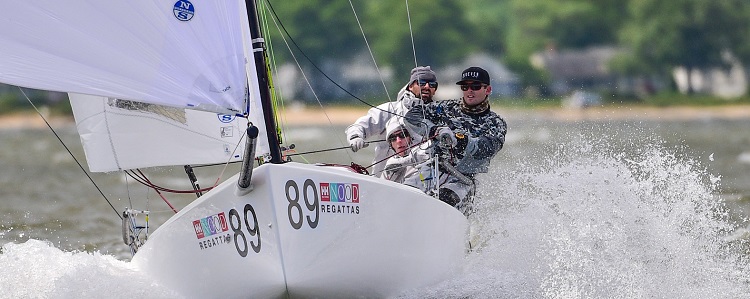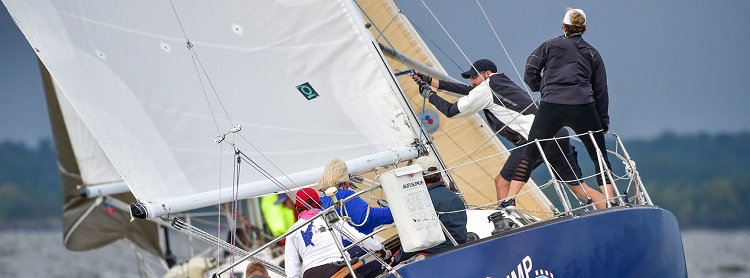The final piece of the training puzzle that we’re taking a look at it strength training.
We’re not getting to strength training last because it isn’t important - it is. We put it last because building muscle mass and “getting jacked” tends to steal the focus of most training regimens to the detriment of all other factors. For sure, working on your strength is important -- we start talking about sheet loads in the thousands of pounds as a boat gets bigger and you’ve got to have plenty of strength to make things happen even with the mechanical advantage of winches and purchase systems.

However, as we’ve tried to point out over the past couple of days, physical strength needs to be teamed with other factors to actually have any staying power. So we’ll assume that you’re already working on your aerobic fitness, activating and strengthening your core, and stretching to improve range of motion and prevent soreness/certain injuries.
When we penned the introduction to our fitness series, we pointed out that there is no such thing as a “sailors workout”. When you start to look into strength training for sailing you start to appreciate how true that really is. Every position on a boat has different physical demands -- a main trimmer will use different muscles than someone tending the mast. The physical requirements of a driver are different than that of a bow guy. And we haven’t even started talking about the differences between dinghy sailors and keelboat sailors.
So how do we tackle all of these different requirements and not have a post that’s 27,000 words? Easy -- we totally cop out.
There’s no way to cover all of the position/boat specific workouts in a single day (though, spoiler alert, it might be the focus of Fitness Week 2019). So what we did is cruise through about 20 articles about sailing fitness and identify the most commonly targeted muscle groups. The results weren’t all that surprising: lower back took the win followed by shoulders, biceps/triceps, abs, and quadriceps.
Then we started looking into what the best exercises for each of those areas was, but with the caveat that we wanted to take away excuses and make sure that anyone could do these exercises whether they could make to the gym or not. This decision clearly sent us down a narrower path, but we think it’s an important one -- it’s always best to remove barriers whenever you can. We also liked a lot of these exercises because they'll increase your strength gradually and shouldn't do so at the expense of your ability to move quickly -- we're not looking to become lumbering bodybuilders here.
When it comes to working your back, shoulders, triceps, and abs, there’s one exercise that almost always comes up: the reliable push up. It’s often called “the perfect exercise” and, while we hate hyperbole, we have to agree that the simple push up (and its many variations) are one of the best options for sailors. As simple an exercise as the push up is, it’s actually very easy to get it wrong, so be sure to focus on form at first and worry about the number of repetitions second.

Contrary to popular belief, you don’t need barbells to work your biceps -- there are plenty of bodyweight exercises to get you through without buying an expensive set of weights. Ideally you’ll have a pull-up bar and one of those can be had for less than $40. We liked this set of bodyweight bicep exercises -- scroll all the way to the bottom for a couple of options that aren’t pull-ups. Resistance bands are also a great way to work biceps without weights and, again, are a fraction of the cost.
Finally, to work on your quads (and legs in general) there are three exercises that you can do: the wall sit, the lunge, and the squat. Each of these can be done without any equipment whatsoever - well, the wall sit does require a wall, but the world is lousy with them and usually nobody minds if you use one - and are very effective lower body workouts.
In the interest of brevity, we've only offered up the best suggestions here, but that's clearly not going to make for a well-rounded workout. You need to mix up what you do and keep things fresh to make it slightly interesting for yourself and maximise the return on your workout. We recommend this website from the American Council on Exercise, which has a wonderful setup that breaks down exercises by body part and allows you filter the results by the equipment you do or don’t have. It’s a great way to expand your horizons and introduce new exercises to your routine.
As with all of the training that we've talked about so far, start slow and work your way up. It's important to find your current fitness level without going past it because that will set you back with soreness and/or injury. For every exercise, start by finding the number of repetitions that you can do without really pushing hard and write that number down. Work towards hitting that number for a couple of sessions and as it gets easier, think about slowly adding more reps. Again, small changes can make a world of difference, so don't feel like you have grow by leaps and bounds - never add more than 10% to your total reps or weights used.




